EL
TRIUNFO
CHIAPAS,
MEXICO
March
2002
The HERPS
The following reptiles were photographed during the March 2002 trip,
and have now been identified, firstly with the help of my friend John Sullivan
and his library (e.g., Campbell 1998, Lee 1996, 2000) [John has a fabulous
web site on his efforts to see and photograph herps around the world],
and then by review by herpetologist Jonathan A. Campbell at the Univ. of
Texas, Arlington. Alas, the references initially reviewed all dealt with
lowland herpetofauna to the north and east of Chiapas so further research
into those of Chiapas was warranted. A summary of Chiapas reptiles has
been published (Alvarez del Toro 1960) and a modern study is in press (fide
G. W. Lasley). Nonetheless, after Dr. Campbell's analysis, we should have
accurate identifications:
Central American Coral Snake Micrurus nigrocinctus: this
is the most common coral snake in, say, Costa Rica and it inhabits a variety
of life zones. I found this one crossing the trail just below Limonal (4200'
elev.) in late afternoon; Greg Lasley came running at my call and caught
it (!). We estimated its size as 2.5-3 feet long, the biggest coral snake
any of us had ever seen:
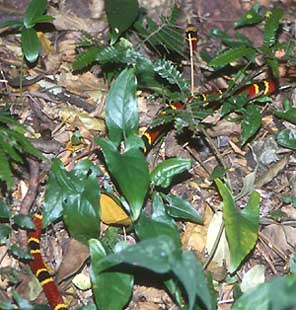

There are about 50 species of coral snake in the genus Micrurus.
The world range of M. nigrocinctus is s. Mexico (Oaxaca) to n. Colombia.
Another photo of this species is on line here.
Campbell (1998) says it ranges to 1300m on the Pacific slope; Limonal is
within this zone. Lee (2000) has this to say about these coral snakes:
"Occurs in many habitats ... terrestrial, secretive, generally
nocturnal, but no exclusively so. Sometimes found in leaf litter on forest
floor or beneath surface debris.... Progresses by quick, jerky movements,
giving impression of nervousness. Dangerously venomous. Some individuals
docile; others bite freely when disturbed. Feeds predominantly on snakes,
including its own species; also lizards. Lays eggs, but reproduction little
known."
Godman's Pit-viper Cerrophidion godmani: this is a
highland species and thus not in the lowland literature we consulted at
all! Greg Lasley identified this snake (and picked it up!); we had a total
of three (3) during the hike from El Triunfo to Canyon Honda (and more
were seen around El Triunfo on previous days). It is the cloud forest viper.
I find it listed in Minton et al. (1965) which gives its range from s.
Mexico to Panama (presumably just the highlands?). A beautiful pit-viper
with rather small fangs (shown to us by Greg), but it was a bit unsettling
to learn that one was living under a log at the edge of our clearing at
El Triunfo.... that one was decidedly larger than the one photographed
here [another is on line here].
Ours was found crossing the trail at mid-morning.
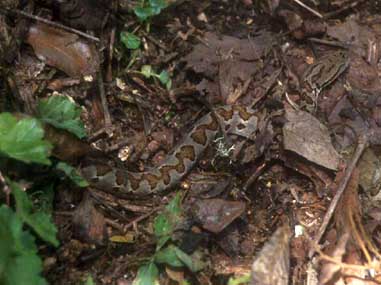
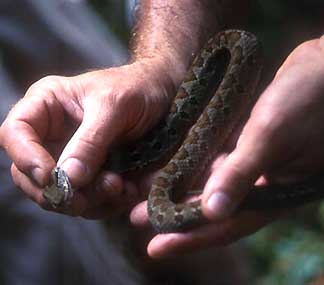
The next snake is non-poisonous. The closest match in Lee's books seems
to be the Tropical Rat Snake
Elaphe flavirufa (possibly a juvenile)
but J. A. Campell advises this is Pituophis lineaticollis, the Middle
American Gopher Snake. The horsemen found this one in the El Triunfo
clearing (6800' elev.) and Greg Lasley caught it. There is another photo
on line, that matches this well, here.
It ranges from central Mexico to Guatemala:
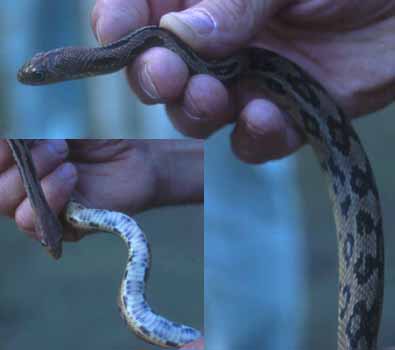
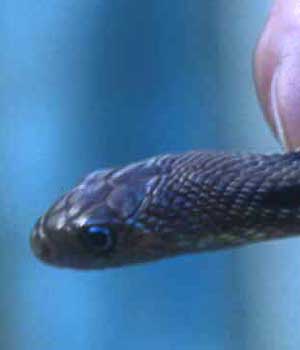
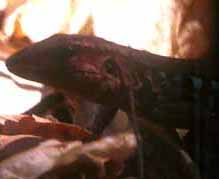 Now
on to lizards. A very common lizard on the hike from Limonal to
Paval, especially in the leaf litter of the oak zone (3500-3000' elevation),
was this one that I initially called a "whiptail." I saw a big beautiful
male with bright turquoise sides (and managed to get this head shot of
it back in 1986; right) but my only photograph in 2002 was this
(apparent) adult female (below). Sullivan says: "Definitely a teid
of some sort, Cnemidophorus (whiptail) or Ameiva (ameiva).
Note that its nose is obscured by a leaf, making it look less pointed than
it really is. I would guess that it's the same species as the one I have
pictured at the top
of one of my web pages, which I believe to be a young female Rainbow
Ameiva
Ameiva undulata." Jonathan Campbell agrees.
Now
on to lizards. A very common lizard on the hike from Limonal to
Paval, especially in the leaf litter of the oak zone (3500-3000' elevation),
was this one that I initially called a "whiptail." I saw a big beautiful
male with bright turquoise sides (and managed to get this head shot of
it back in 1986; right) but my only photograph in 2002 was this
(apparent) adult female (below). Sullivan says: "Definitely a teid
of some sort, Cnemidophorus (whiptail) or Ameiva (ameiva).
Note that its nose is obscured by a leaf, making it look less pointed than
it really is. I would guess that it's the same species as the one I have
pictured at the top
of one of my web pages, which I believe to be a young female Rainbow
Ameiva
Ameiva undulata." Jonathan Campbell agrees.
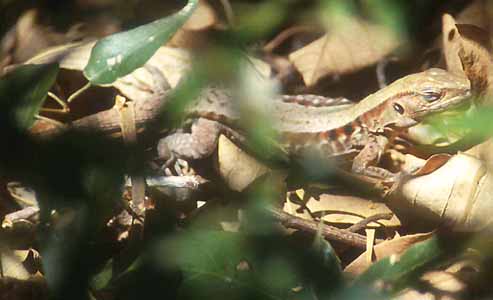
The next lizard was rather high in the cloud forest above Canyon Honda;
perhaps at 6000' elev. or a bit lower. I thought it might be an alligator
lizard. Sullivan says: "Definitely an anguid, almost certainly Gerrhonotus
or Elgaria sp. Lee's books don't include any of these, so I [can
only guess what it is]" Our cloud forest example was rather green in color.
Conant (1958) writes: "Check for flexible groove than runs along the side
from neck to hind leg." This groove is apparent in the photograph. Jonathan
Campbell identifies this as Mesaspis moreleti, the Central American
(or
Morelet's) Alligator-Lizard. An interesting new DNA study that included
this species (Macey et al. 1999) shows that the anguid lizards arose on
Gondwanaland and were separated by the formation of the Atlantic Ocean
in the late Eocene. Some anguids remained in North America (the alligator
lizards in the subfamily Gerrhonotinae) while others thereafter evolved
in Europe and North Africa (the Anguinae). Interesting stuff...
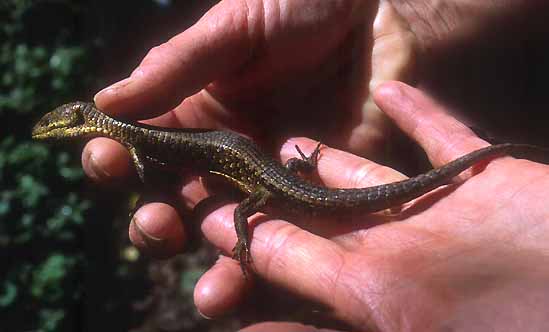
Below Limonal and down to Paval (say, 3500' elevation to 1300'), many
Sceloporus
were common in the leaf litter. In 1986, I photographed this adult (below
left) and in 2002 this juvenile (below right). Jonathan Campbell has tentatively
identified the adult as Sceloporus internasalis
in the S. formosus
group. Although some have lumped this with
S. salvini (Salvin's
Spiny Lizard). Dr. Campbell tells me (in litt.) that unpublished work (both
field work and biochemical analysis) support S. internasalis as
a good species. Alas, neither John Sullivan nor I can find an English name
as yet; Dr. Campbell or colleagues may have to coin one.
I'm not sure if the youngster is the same species.
It was quite small and reminded me of various small Sceloporus in
California. It is possible it is a Rose-bellied Lizard S. variabilis
that ranges from south Texas to Costa Rica, and does occur in Chiapas according
to on-line resources.
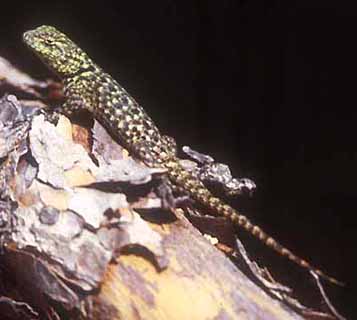
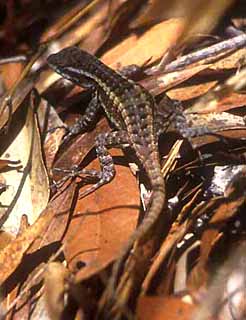
The final lizard is "definitely a very young Striped Basilisk
aka Brown Basilisk Basiliscus vittatus" says Sullivan. This was
at Paval (1200' elev.) near the river. Basilisks are known as "Jesus Christ
lizards" since they appear to "walk on water" when crossing streams or
ponds on their very long toes. They are very fast runners and actually
do run across the surface of the water, using their speed combined with
the large surface area of their hind feet, to avoid completely breaking
the surface tension of the water. They can, indeed, "walk on water."
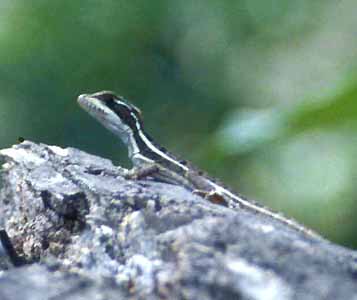
In addition to these photographed reptiles, a very large Green Iguana
Iguana
iguana was seen by some in the trees at our hotel in Tapachula, and
(of course) there were many frog tadpoles in our swimming holes on the
hike down the Pacific slope.
Thanks very much to John Sullivan and to Jonathan A. Campbell for their
comments and analysis, and to Greg Lasley for the close views of many of
these!
PHOTOS: The photos are © 2002 Don Roberson, all rights reserved.
Literature cited:
Alvarez del Toro, M. 1960. Los reptiles de Chiapas. Inst. Zool.
Estado, Tuxtla Gutierrez, Chiapas, Mexico.
Campbell, J. A. 1998. Amphibians and Reptiles of Northern Guatemala,
the Yucatan, and Belize. 1998. Univ. of Oklahoma Press, Norman, OK.
Conant, R. 1958. A Field Guide to Reptiles and Amphibians of the United
States and Canada east of the 100th Meridian. Houghton Mifflin, Boston.
Lee, J. C. 1996. The Amphibians and Reptiles of the Yucatan Peninsula.
Cornell Univ. Press, Ithaca, N.Y.
Lee, J. C. 2000. A Field Guide to the Amphibians and Reptiles of the
Maya World: the Lowlands of Mexico, northern Guatemala, and Belize. Cornell
Univ. Press, Ithaca, N.Y.
Macey, J. R., J. A. Schulte II, A. Larson, B. S. Tuniyev, N. Orlov,
and T. J. Papenfuss. 1999. Molecular phylogenetics, tRNA evolution, and
historical biogeography in anguid lizards and related taxomonic families.
Molecular Phylogenetics & Evolution 12: 250-272.
Minton, S. A., Jr., H. G. Dowling, and F. E. Russell, eds. 1965. Poisonous
Snakes of the World: a Manual for Use by U.S. Amphibious Forces. U. S.
Dept. Navy, Bureau of Medicine & Surgery, Gov't Printing Office, Washington,
D. C.
TOP
BACK
TO EL TRIUNFO PAGE
GO TO LIST OF BIRD
FAMILIES OF THE WORLD
GO TO HERPS OF
WORLD PAGE
GO TO MONTEREY COUNTY
PAGE
GO TO HOME PAGE
Page created 1-15 Apr 2002






 Now
on to lizards. A very common lizard on the hike from Limonal to
Paval, especially in the leaf litter of the oak zone (3500-3000' elevation),
was this one that I initially called a "whiptail." I saw a big beautiful
male with bright turquoise sides (and managed to get this head shot of
it back in 1986; right) but my only photograph in 2002 was this
(apparent) adult female (below). Sullivan says: "Definitely a teid
of some sort, Cnemidophorus (whiptail) or Ameiva (ameiva).
Note that its nose is obscured by a leaf, making it look less pointed than
it really is. I would guess that it's the same species as the one I have
pictured at the
Now
on to lizards. A very common lizard on the hike from Limonal to
Paval, especially in the leaf litter of the oak zone (3500-3000' elevation),
was this one that I initially called a "whiptail." I saw a big beautiful
male with bright turquoise sides (and managed to get this head shot of
it back in 1986; right) but my only photograph in 2002 was this
(apparent) adult female (below). Sullivan says: "Definitely a teid
of some sort, Cnemidophorus (whiptail) or Ameiva (ameiva).
Note that its nose is obscured by a leaf, making it look less pointed than
it really is. I would guess that it's the same species as the one I have
pictured at the 



